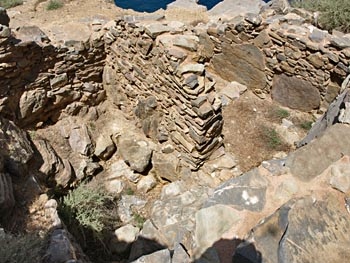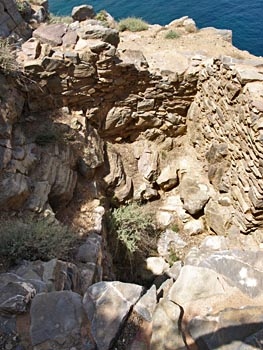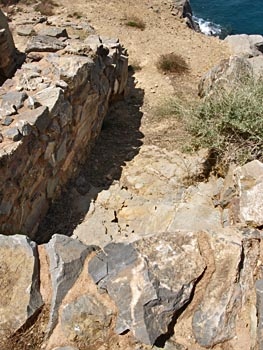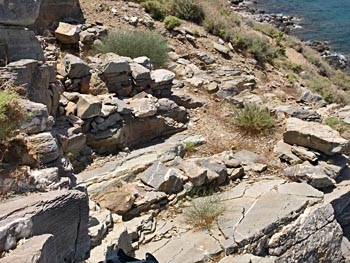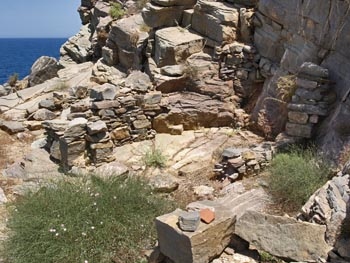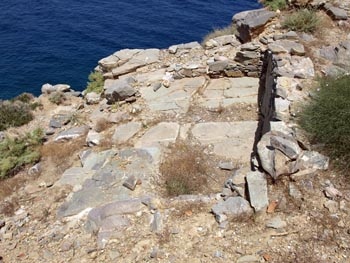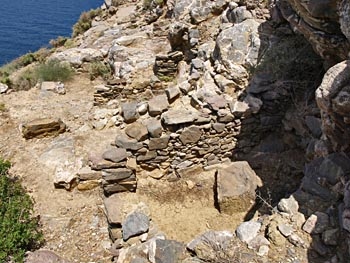Highly significant prepalatial tombs
This is one of the largest and most significant of the surviving Early Minoan cemeteries in Crete. Excavators have uncovered more constructed tombs here than at any other cemetery of any period. During the original excavations in 1908, Richard Seager discovered more than 20 built tombs on the island. Pit graves, rock shelters and burials in pithos jars were also found.
The tombs are to be found in two separate areas. On the western side of the island there is a terrace with several monumental tombs, presumably those of the local rulers. To the south, running along the contours of the hill were found a large number of more basic tombs, presumably for the ordinary people of the settlement.
The house tombs date from the EM II phase and continued to be used in EM III. Some were even used in the following MM IA phase, when they subsequently all went out of use. In the Neopalatial (Second Palace) period, some of the tombs were brought back into service and the use of pithos burials became common.
As a result of cleaning operations on the site in the 1970s 28 excavated tombs were located. Many more have come to light in the intervening years.
The West Terrace
The West Terrace is the site of the monumental tombs, probably belonging to the elite families from the settlement. The terrace is nothing more than a narrow strip of land bordered by the cliffs to the north and east and a drop to sea level on the west. So the only access to the tombs is from the south.
The first tombs one reaches consist of tombs I, II and III, on the right. These are not in fact three separate tombs but a single tomb complex with three separate rooms.
The tomb complex runs north to south along the contour of the hill and in the central part of the tomb known as compartment I, there are two small rooms which orientate east-west, each with an entrance from the west and an adjoining entrance at the far end of the rooms. The north and south compartments (III and II respectively) each consist of one long oblong room running north to south and it is thought the north room may have been added at a later date.
Both compartments I and II had skeletal remains when excavated. It seems that the northern room of compartment I had never been used for burials but in the southern room of compartment I more than 30 skulls were uncovered and EM IIA seems to be the most likely date for these burials.
In compartment II (south of compartment I) pottery finds dated the lower stratum to EM IIA and the stratum above it to EM IIB and EM III. Some MM III pottery was also found but not associated with any burials.
Compartment III (north of compartment I) contained no human remains although it is possible that an EM burial had been cleared out at a later period as some gold and silver objects were located there.
Tomb complex IV, V, VI

Compartment IV with the remains of the dividing wall added later and the threshold stone and entrance at the top of the picture
Tomb complex IV, V, VI is extremely well preserved. Many of the walls still stand to their original height. They are built completely of stone. The building is rectangular with three compartments and again it should be considered as one tomb complex rather than three separate tombs. The tomb faces south with cliffs behind and to the east and a spectacular drop to the sea to the west.
The main entrance to the tomb is in compartment IV, which is the central compartment. The narrow entrance crosses a single slab of stone (the threshold). Seager believed that the tomb was sealed by a huge single slab of stone but Soles, investigating the site in the 1970s, thought that a wooden door was a distinct possibility.
The wall across compartment IV was certainly added at a later date. Originally it would have been one room with access at its far end to compartment VI, to the east. This seems to have been the only way to gain access to compartment VI.
Compartments IV and VI taken together seem to form a butt and ben construction and therefore probably predate compartment V, which as well as being added later seems to have been more crudely constructed and a less significant area. The fact that its north wall overlaps the north wall of compartment IV again suggests a later addition.
In the period before compartment V was built the initial burial would have been in compartment IV. When the body had decomposed the bones would have been moved to compartment VI to make way for fresh burials. Over time it became necessary to build a second ossuary for the bones removed from compartment IV and so compartment V was added. Soles believes that the house tombs at Mochlos, like the tholos tombs, were used by a group slightly larger than a single nuclear family.
In front of the tomb complex there is a pavement which runs from east to west immediately in front of the tombs. This pavement is incomplete and ends at the central compartment IV. South of the pavement is the remains of a terrace which stretches in a north south direction. A small platform raised half a metre above the pavement is thought to be an altar.
In compartment IV an EM II burial was found as well as a MM III level with no signs of burial having taken place. In compartment VI important finds of stone vases and gold jewellery from the EM II period were made. Above it some very basic MM III/LM I grave goods were recovered suggesting to Seager that poor people had been buried here. If that was the case, what had happened to turn royal tombs into the tombs of ordinary people?
Compartment V produced skeletal remains and pottery from EM II and EM III but it is thought that all of this was dumped here having been moved from somewhere else.
At the end of EM IIA the tomb seems to have undergone some rebuilding. Compartment V seems to have been added then, perhaps to deal with the overflow from the two existing compartments. The tomb complex then remained in use until MM III.
Tomb Λ (Lambda) and Building Ξ (Ksi)
Tomb Λ is the largest of the tombs outside the group on the west terrace, and is located high up on the southern slope well away from the other tombs in the area. An earlier, smaller tomb was found inside together with a pit where a cremation had taken place. The excavators believe that Tomb Λ had deliberately been built to incorporate these earlier tombs.
Both ash and fragments of bone were found in the cremation pit, which also contained EM IIA pottery. The excavators believe the cremation happened elsewhere and that the human remains and ash were scooped up and placed in this pit afterwards. Nevertheless, this makes it the earliest cremation known in Minoan Crete, and is a lucky find since the Minoans did not normally practise cremation burials.
The other tomb found inside Tomb Λ was originally a single chamber about one metre by one metre. Finds included parts of three jugs and small pieces from a Triton shell.
Due to looting in the past finds in Tomb Λ from different periods were found mixed up. Finds included pottery from EM II to MM I. One of the finest pieces retrieved was a cylinder seal from Syria which is described and illustrated in the 1989 excavation report, free to download from the Hesperia website. Some human bones were found, including long bones which seem to survive better than the smaller ones.
Building Ξ still stands to a height of one metre in some parts. The floor is lower than the land outside so four steps lead down from the entrance. A large number of broken plates were found, with holes in their rims. It is not known what the building was used for, but the excavators compare it to a building in the Phourni cemetery in central Crete which also had steps down into the interior of the building. The Phourni building was used to store offerings made in the cemetery and although it was still functioning in LM III its origins seem to be much earlier. So this could be a clue to the use of building Ξ.


